Tag Archive for: risk management
Simple Trade Management
/by Peter BrandtSimple Trade Management – Standing the Test of Time.
I have absolutely no control if the next trade or series of trades will be profits or losses. However, with a proper Trade Management process, I know that I only have control over:
- The patterns I identify as trading opportunities – do they meet a certain standard?
- The orders I enter – is my order entry processes consistent with conducting trading as an organized business enterprise?
- Leverage and sizing – (Risk Management) am I risking too much, but also, am I risking enough to make a trade matter if I am right?
- Ongoing Trade Management – am I taking the right balance between protecting capital and allowing a trade to fully develop?
I want to be able to look at past trades on a chart a year or more after the fact (both entry and exit) and be able to say – “YES, that trade made sense, my sizing was right, my trade management was precise.” Picture this concept: If I blow up charts to wall-sized and stick pins into price bars at every spot where I bought and sold, will the placement of all the pins make sense a year after the fact? If I look at a pin and say, “I have no idea what I was thinking in that trading action,” then I have some serious issues I must address in my trading operations. Food for thought?
Factor Membership is now available. You could consider your membership in the Factor Service as just one more trade. If the Factor Service is not of value to you, well, it is just one more trade that did not work. Through the Factor Service I endeavor to alert novice and aspiring traders to the many pitfalls you will face – and to offer advice on overcoming those pitfalls. My goal is to shoot straight on what trading is all about. For more information, visit the home page here. Or watch my 30 minute webinar where we cover the Factor service in depth.
I hope you will consider joining the Factor community.

##
Trading Futures and Forex related ETF’s is a foolish way to manage trading capital
/by Peter Brandt
Why trade an ETF when the underlying Futures or Forex contract can be traded.
Trading an ETF tied to an underlying Futures or Forex market requires far more capital with less profit potential at the exact same level of risk as directly trading the underlying futures or forex contract. Five examples are provided to make my point.
- S&P futures vs. SPY
- S&P futures vs. SH (inverted SPY)
- British Pounds futures vs. FXB
- Gold futures vs. GLD
- Copper futures vs. JJC
Assumptions:
- An ETF represents a specific futures or forex market
- A loss of $10,000 is risked per trade – in both the futures/forex and ETF expressions of a trade. A risk of $1,000 would simply require dividing the key numbers by 10
- The entry and exit for each trade (futures/forex vs. the ETF) are made simultaneously – same date and time
- The corresponding charts for each trade set up are shown
Note: This post will no doubt create some level of controversy and disagreement. This is my intent. I will stand by my position that trading an ETF tied to an underlying futures or forex market is a very foolish way to manage trading capital. I have no idea why a trader would ever trade a futures or forex-related ETF if he or she can handle the risk of the futures and forex markets. Let the facts of this document speak for themselves.
S&P 500 – Shorting the H&S top in May 2012
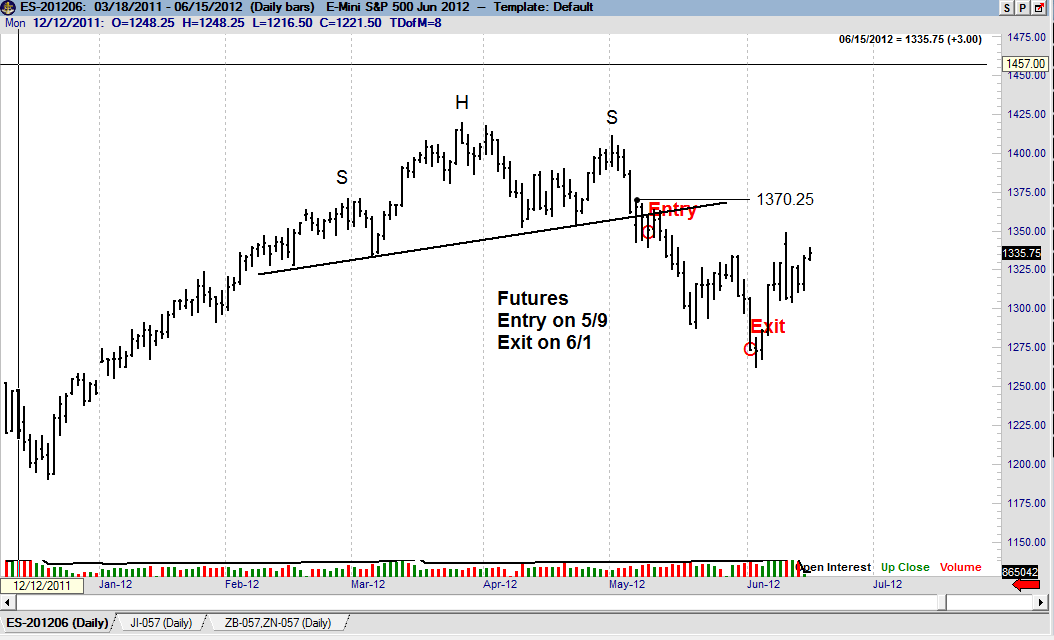
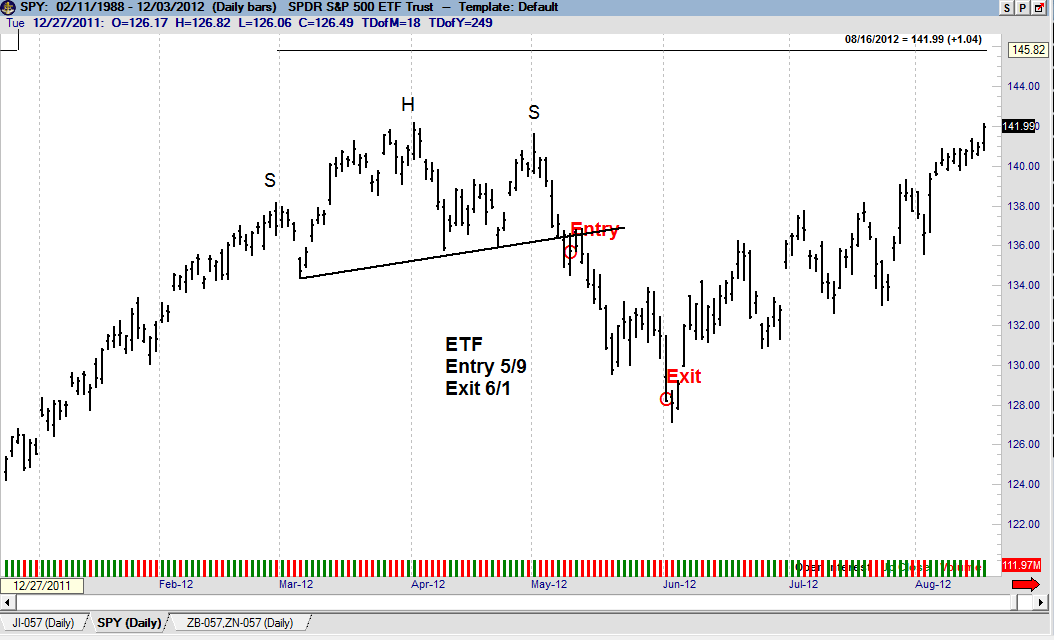
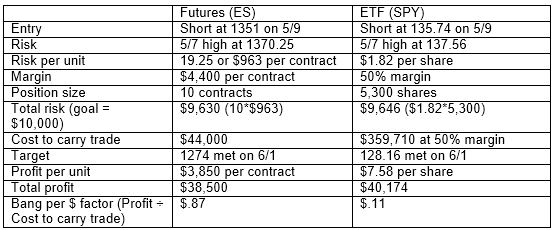
Summary: Trading SPY ties up eight times more capital in a trade with a near-identical risk to reward profile. FOOLISH!
S&P 500 – Shorting the S&P top in May 2012 with an inverse ETF
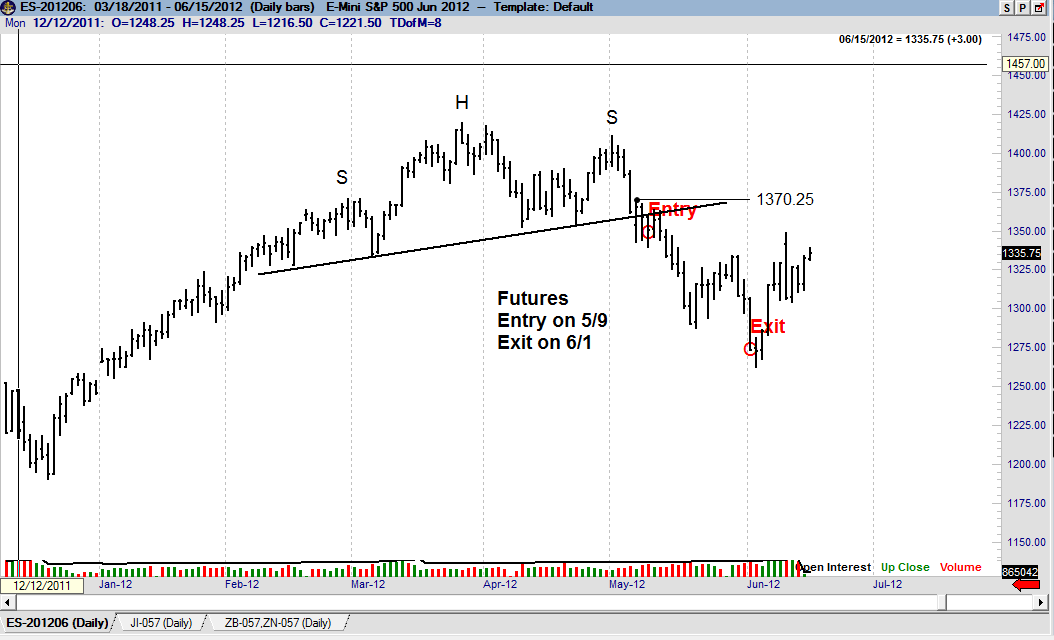
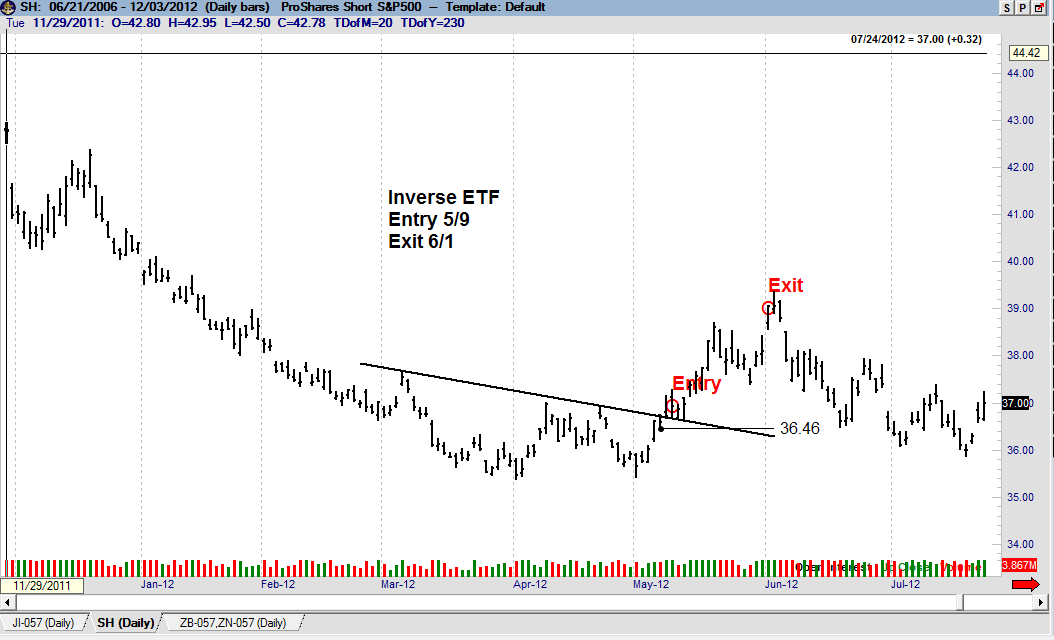
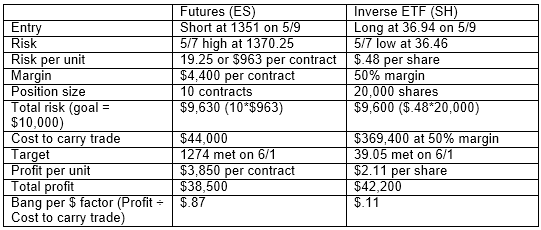
Summary: Trading an inverse S&P ETF (SH) ties up eight times more capital in a trade with a near-identical risk to reward profile. FOOLISH!
British Pound – Buying the descending triangle bottom in August
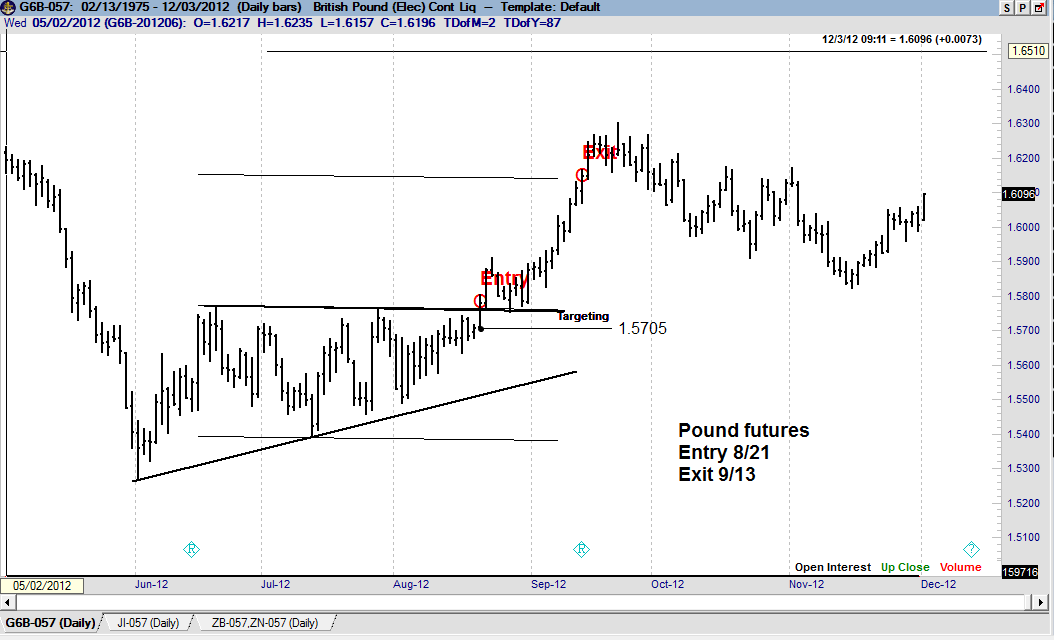
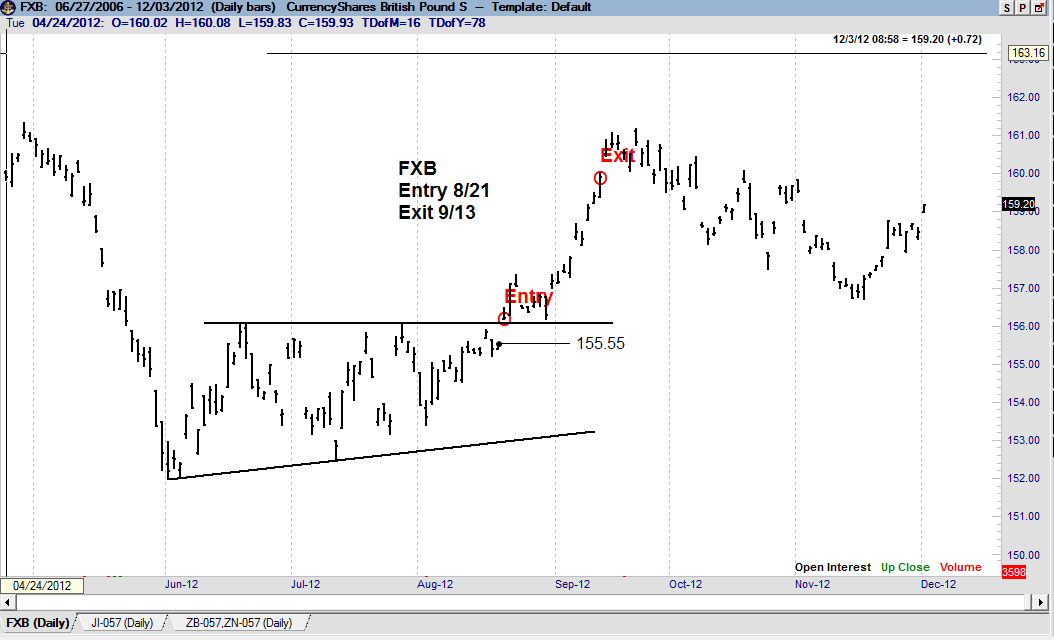
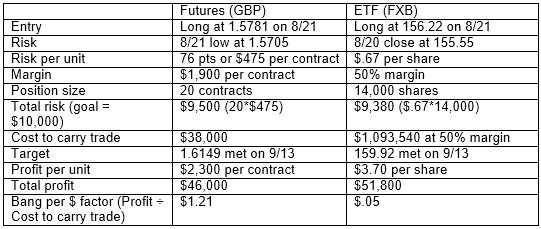
Summary: Trading a long British Pound ETF (FXB) ties up 24-times more capital in a trade with a near-identical risk to reward profile. FOOLISH! REALLY FOOLISH! JUST PLAIN STUPID!
Gold – Buying the symmetrical triangle in August 2012
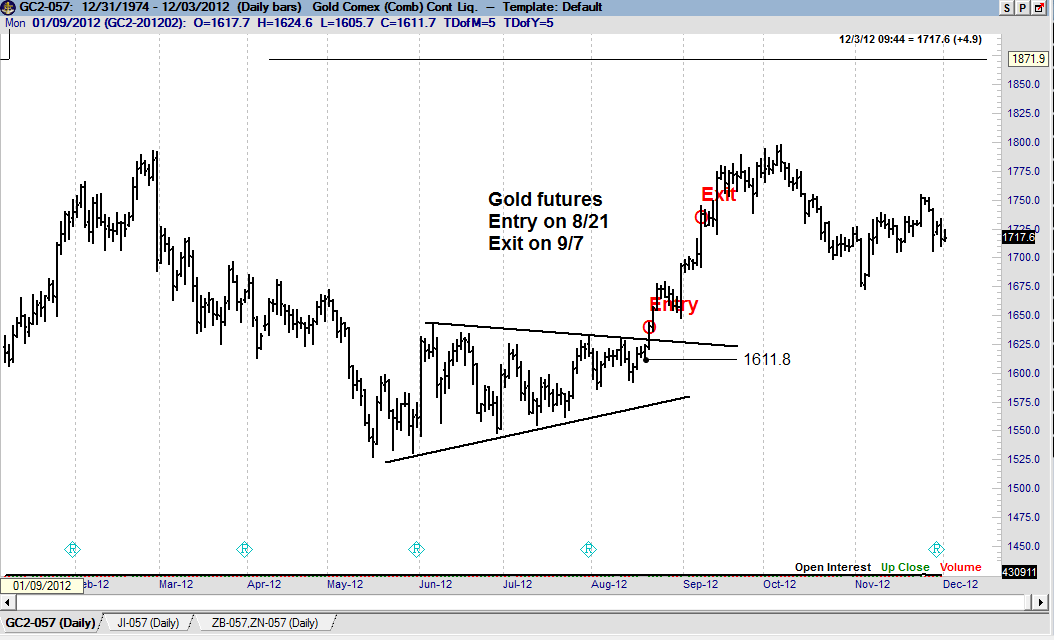
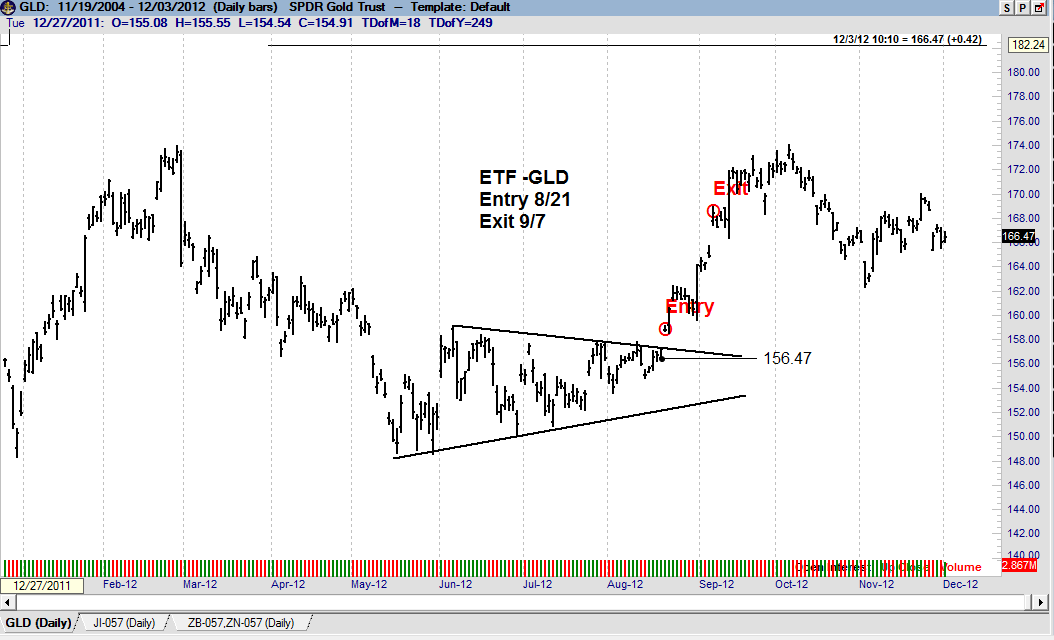
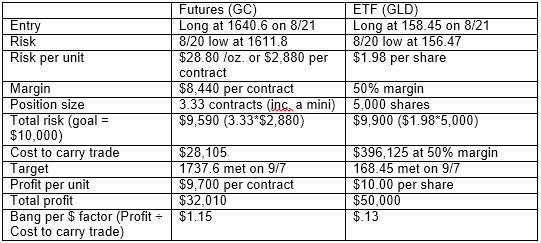
Summary: Trading a long Gold ETF (GLD) ties up nine times more capital in a trade with a near-identical risk to reward profile. FOOLISH!
Copper – Buying the 3-month -compound fulcrum bottom in September 2012
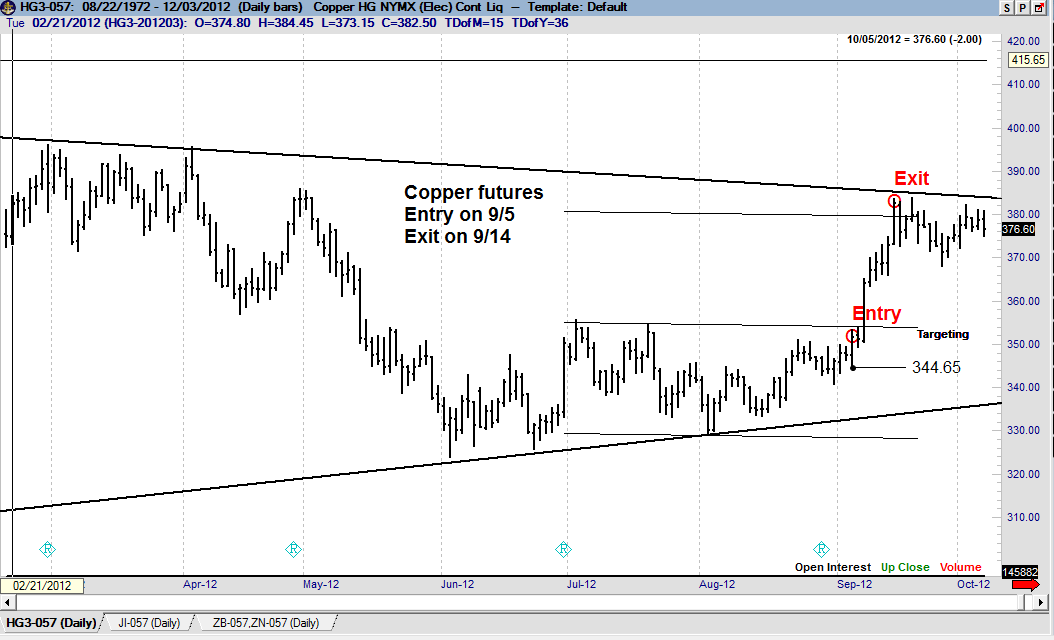
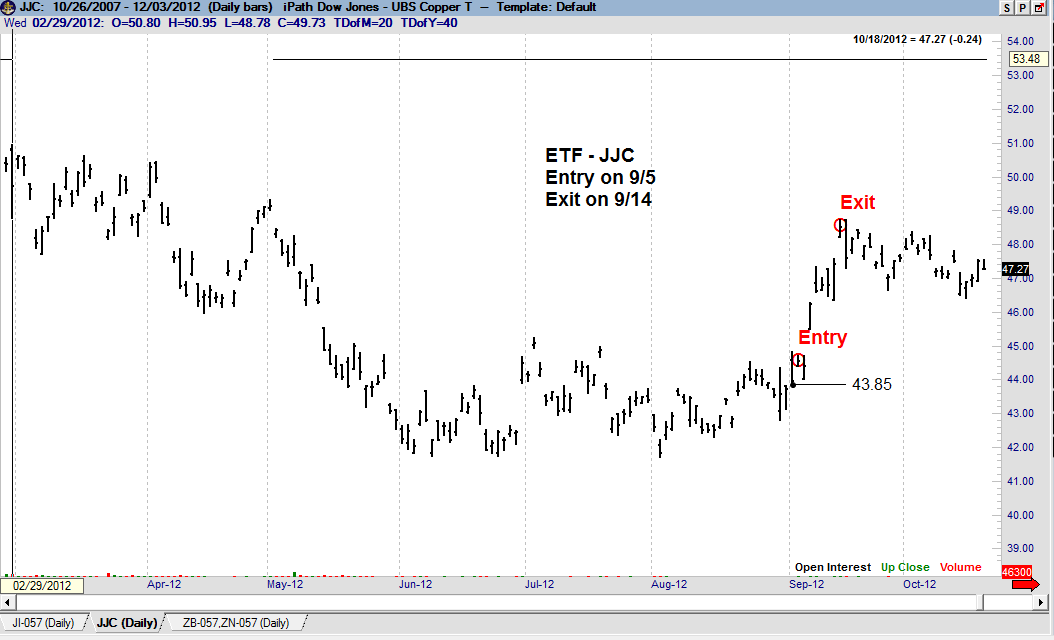
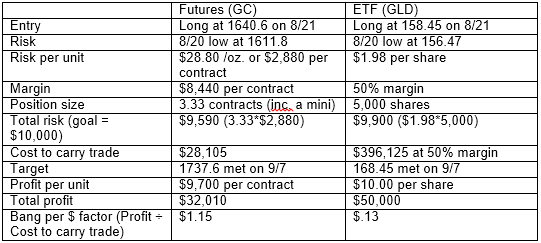
Summary: Trading a long Copper ETF (JJC) offered 25% more profit potential, but tied up eight times more capital in a trade with a near-identical risk profile. FOOLISH!
Summary
I could go on and on with these examples — to interest rate markets, grains, energy, food and fiber, every conceivable forex pair.
No matter how you stack it, using ETFs when underlying futures or forex contracts are available is an absolutely foolish utilization of trading capital.
With the sole of exceptions of having an account with too little capital to trade futures or an IRA or Roth account unable to use futures, why a person would trade GLD or SLV or SPY or any number of futures/forex-related ETFs in beyond my comprehension?
For the same risk per trade (expressed in dollars or as a percent of a trading account), futures/forex provide the following advantages:
- More liquidity
- Fewer overnight gaps
- 24-hour trading access (in most cases)
- Ability to hold far more different trades at the same time
- Great punch per dollar employed to hold a trade – in fact, capital in futures is about eight to 10 times more efficient at an equal-risk level
- Shorts in futures cannot be called back (as is the case with a short ETF position)
If you are a properly capitalized trader (I would saying anything north of $100,000 of non-IRA trading assets) you need to seriously challenge your use of ETFs instead of the underlying futures contract or forex cross.
PLB
###
Losing to Win
/by Peter Brandt
Losing to Win – Trading Commentary
I sometimes sense from email correspondence I receive from the Factor community that there is an obsession in being “Right” when trading or put another way, concern that their analysis might be “wrong.”
Running the risk of offending, this worry about being right or wrong on a trade or an analysis puts up a major red flag in my mind.
I learned early on at the Chicago Board of Trade that the road to long-term profits runs through the city of Losses.
Worry or concern that a trade will be a loser is a major hurdle to profitability.
Professional traders understand that the goal of trading is to make money, not to be right. Making money in the markets requires losses — a lot of losses. Most traders I know are right no more than 40% or 50% of the time — this means they are wrong and take losses on 50% to 60% of their trades. Being wrong is part of trading. It comes with the territory. My default frame of mind as I enter any trade is that it will be a loser.
One of the major mistakes made by novice traders is that their bet size is much too large — often they risk 5%, 10%, or more of their capital on an individual trade. At this bet level I, too, would be worried about being wrong. Betting 10% of your capital on each trade is a sure way to wipe out your trading account. Someday I will explain why statistical probability will lead to ruin, but not today.
It is the fear of losses that leads many novice traders in search of holy grail trading systems that promise to be right on 80% or more of the time. Good luck with that one. If you are in possession of such a system and it delivers on the promise, then you are smarter than am I.
If the fear of losing characterizes your trading, then I offer a couple of thoughts.
First, settle on how you plan to trade and handle risk management, then paper trade for a year or so.
Second, when you begin to trade real money, risk no more than 30 to 50 basis points on each trade.
Third, if you have too small of an account to permit a risk as little as 50 BP, then you might think about endeavors other than trading.
There is a fine line between being fearful of the markets and having well-deserved respect for how much damage the markets can deliver to carelessness. You need to be on one side of this spectrum or the other. Being on the side of fearfulness is something that can be overcome — and that is the good news.
See the home page for details regarding Factor Membership options: https://www.peterlbrandt.com
plb
###
Layering and Trade Management
/by Peter BrandtTrading Futures and Forex Markets with $100k
/by Peter BrandtTrading Futures and Forex Related ETFs is a Foolish Use of Capital
/by Peter BrandtLearning From Trades That Do Not Work
/by Peter BrandtWhat Trading Over the Course of Five Different Decades has Taught Me About Drawdowns
/by Peter BrandtIf You Want to Learn How to Win as a Trader, You Must First Learn How to Lose
/by Peter BrandtRecent Posts:
 Primer: Interest Rates & The Fed (+FREE .PDF)December 3, 2025 - 8:30 pm
Primer: Interest Rates & The Fed (+FREE .PDF)December 3, 2025 - 8:30 pm Loss Aversion: A Mental Trap Every Trader Needs to KnowNovember 19, 2025 - 6:52 pm
Loss Aversion: A Mental Trap Every Trader Needs to KnowNovember 19, 2025 - 6:52 pm Three Day Trailing Stop (Video)October 24, 2025 - 5:25 pm
Three Day Trailing Stop (Video)October 24, 2025 - 5:25 pm One Year Later: GE, Classical Charting, and Avoiding Dead MoneyJuly 22, 2025 - 1:01 pm
One Year Later: GE, Classical Charting, and Avoiding Dead MoneyJuly 22, 2025 - 1:01 pm








